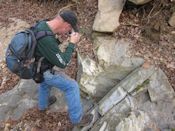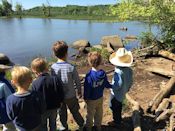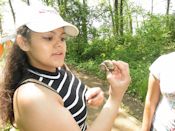On May 14, 2017, FODMers observed several common or northern watersnakes (Nerodia sipedon sipedon) off both sides of the boardwalk. These snakes are more active on sunny days than on cloudy days and are known to mate near the water's edge on logs, over rocks or on branches. Their coloration helps them camouflage, but movement in the cattails may give away their presence.
On May 10, 2017, Rod Simmons spoke to an enthusiastic audience of 60 and explored the geology of the Washington area and how it gives rise to diverse natural communities, calling the Washington-Baltimore region “the most geologically and floristically diverse area in the eastern United States.” Rod is the Natural Resource Manager and Plant Ecologist for the city of Alexandria.
There is one active bald eagle nest in the Dyke Marsh Wildlife Preserve this spring, 2017, confirmed by a National Park Service biologist’s helicopter survey conducted before trees leafed out. Our fingers are crossed for some fledged young. Bald eagles that hatch in April in this area usually can fly and leave the nest in early June.
Forty pre-schoolers from St. Luke's Episcopal Church Day School, Mount Vernon area, visited the Dyke Marsh Wildlife Preserve on May 8, 2017, with their teachers. The youngsters had a scavenger hunt and looked for birds, shells, gum balls, paw prints, cattails and critters.
Thirty youngsters from Washington, D.C., Inspiring Connections, all students at Caesar Chavez Public Charter School for Public Policy and their three D.C. Sierra Club chaperones, learned all about freshwater wetlands and the flora and fauna of the Dyke Marsh Wildlife Preserve on April 29.






